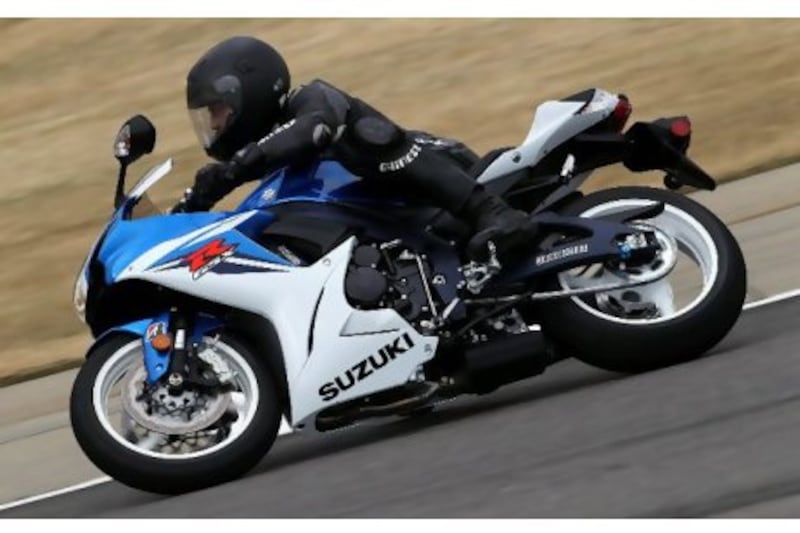Like the supersized who worship all things McDonald's, motorcycles - at least of the sporting variety - are at their best after shedding a few kilograms. Light is good; lighter is better. And like the North American crisis of corpulence that has elevated dieting to cultural obsession, motorcycle companies are seemingly willing to go to any lengths to see their charges drop even just a few kilograms.
Think I am exaggerating? I just spent two hours in the conference room at the Barber Motorsport Park's palatial clubhouse, in the US state of Alabama, listening to a Suzuki techie talk - with a fervour that would do a fitness guru proud - about how the company's 2011 GSX-R600 has shed some much needed avoirdupois.
The company, for instance, completely redesigned the motorcycle's seat - its foam, its base, its shape - to save a paltry 240 grams. For those trying to picture that in real terms, that's about the weight of your TV remote controller.
Think that's extreme? The company also claims that it redesigned the middleweight Gixxer's starter motor to save 28 measely grams, barely enough, were it oregano or thyme, to season a pot of spaghetti.
What this beyond-fanatical dedication to two-wheeled bulimia has done, however, is reduce the 2011 GSX-R600's curb weight by some 9kg. And like any human dieter can attest, a loss that dramatic is immediately noticeable.
It's readily apparent just poodling down Barber Motorsport's pit lane. And by the third corner of this very curvy racetrack, it's confirmed; like sprinters, hot air balloons and stick-thin runway models, motorcycles benefit from weight loss. Aboard the new GSX-R, even decreasing radius, off-camber uphill turns - the ones that usually challenge my talent and choice of braking points - are easily navigated. The reduced weight almost renders true the ages-old adage of just thinking about turning causing the motorcycle to dive for apexes.
But the best thing about this newfound sprightliness is that it comes without penalty. Often, when engineers are trying to render their sportbikes more responsive, they'll try all manner of tricks, like changing weight distribution or tightening up the front end's steering angle. And while that may indeed result in quicker, more responsive steering, other criteria - like high-speed stability and weight transfer during heavy braking - are compromised.
Suzuki did none of the above. Indeed, the new Gixxer has the same rake (steering angle) and trail as the outgoing model (the wheelbase is shorter, however). That means that, while it turns on the proverbial dime for the Barber's hairpin turns (four and six) thanks to its lighter curb weight (now 187kg), the new GSX-R retains all its stability through the two fourth-gear high-speed kinks on the back of the track.
Virtually every aspect of the 600's performance has been improved by its lighter weight. Suzuki makes much of 599cc engine's increased mid-range torque, but the upgrades - slightly higher compression, different crankcase venting, lighter pistons and slightly revised camshaft profiles - from 2010 are minimal. There might be a bit extra torque in there somewhere, but the real reason the 2011 feels so peppy is that there's less mass to move and the close-ratio gearbox's ratios have been shortened. It doesn't matter; where last year's middleweight Suzuki definitely felt middle of the pack, the 2011's acceleration is at the top of the class.
Other highlights of Suzuki's chassis makeover include this year's Big Piston Front Fork. More consistent damping is promised thanks to, well, a bigger damping piston, and more sophisticated valving. I can't speak as to whether street riders will notice a dramatic improvement in comfort but I can say that the front suspension was nigh on perfect for track use. Usually, standard factory settings for suspension components provide a mere baseline for personal experimentation, but throughout the entire time I spent trying my best to grind knee pucks into dust, I could find no reason to alter the suspension settings even one preload click.
Surprisingly, the one area of complaint was the GSX-R's new front brake. I say surprisingly because Suzuki has gone to the expense of replacing its traditional Nissin hardware with some exotic Brembo four-piston calipers. While tha Italian stoppers were admirably powerful and provided plenty of feedback, they did get spongy after just three laps, the brake lever often coming almost back to the handlebar until it was readjusted. The brakes would remain powerful despite the greater lever movement, but it did require frequent adjustment of the front brake lever. Gixxer owners would be well advised to invest in some stainless steel brake lines.
But that's about all the changes I would make to the new GSX-R. The stock suspension, engine, even the tyres - Bridgestone BT-016s - were nigh on perfect for a day of spirited track day riding. Indeed, the Gixxer, along with Triumph's 675 Daytona, would be my top pick for a track day weapon.






